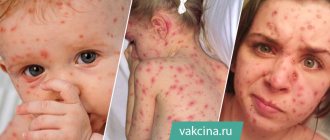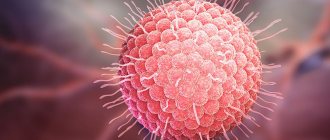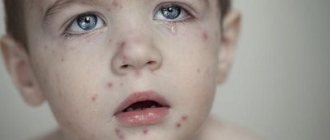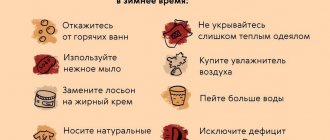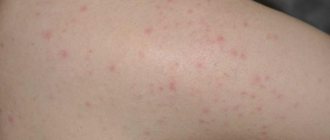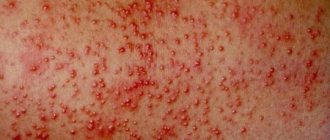How dangerous is chickenpox?
Chickenpox itself is a common disease and does not pose any threat. But the complications that it can entail in the human body are dangerous. Chickenpox weakens the immune system, and at this point the risk of becoming more seriously ill increases.
Complications such as pneumonia, myocarditis, encephalitis and some others may occur. Therefore, you need to know how and with what to treat chickenpox in order to stop the undesirable development of events in time. Chickenpox manifests itself in adults in different ways; depending on the course of the disease, certain medications are prescribed.
What complications can occur with chickenpox?
The disease is usually mild, but complications may occur, including bacterial infections (eg, bacterial skin lesions, pneumonia) and neurological infections (eg, encephalitis, meningitis, myelitis), which can be fatal.
Secondary bacterial skin infections, which are caused by streptococcus or staphylococcus, are the most common cause of hospitalization and outpatient medical visits. Secondary infection with invasive group A streptococci can cause abscesses and cellulitis.
Pneumonia after chickenpox is usually viral, but can also be bacterial. Secondary bacterial pneumonia is more common in children under 1 year of age. It is characterized by an increase in temperature up to 40⁰C, an increase in pallor and cyanosis of the skin, the appearance of a substernal dry cough and shortness of breath. Patients can take a forced position in bed.
Damage to the central nervous system in chickenpox ranges from aseptic meningitis to encephalitis. Cerebellar involvement followed by cerebellar ataxia is the most common presentation of central nervous system disorders but usually has a positive outcome.
Encephalitis is one of the most dangerous complications of chickenpox (10-20% of cases are fatal). This complication manifests itself as headache, nausea, vomiting, convulsions and often leads to coma. Diffuse brain involvement is more common in adults than in children. Chickenpox meningitis may occur together with encephalitis or independently.
Rare complications of chickenpox include Guillain-Barré syndrome, thrombocytopenia, hemorrhagic and bullous chickenpox, glomerulonephritis, myocarditis, arthritis, orchitis, uveitis, iritis and hepatitis.
Once infected, the virus remains hidden in nerve cells and can be reactivated, causing a secondary infection, herpes zoster. It usually occurs in adults over the age of 50 or with a weakened immune system and is associated with a painful rash that can cause permanent nerve damage.
Antipyretics
Adults who did not develop immunity to chickenpox in childhood sometimes find it difficult to tolerate this disease. The debilitating high temperature lasts for several days. It must be knocked down in order to alleviate the patient’s condition and prevent new rashes from spreading.
If you have chickenpox, you cannot relieve the fever with aspirin; it is better to use paracetamol. You need to take the drug starting at +38 C. Paracetamol is also safe for chickenpox in pregnant women, but in this case the dosage is much less. It must be remembered that the rules of use are as follows:
- no more than three days;
- with an interval of 4-6 hours;
- single dose 500-1000 mg;
- maximum daily dose - 4 grams;
- 1-2 hours after eating;
- drink plenty of water.
You can take cold medicines like Coldrex and others, they are based on the same paracetamol. But this is only in the early days, when the disease is just beginning. In the decisive phase, you cannot do without paracetamol in its pure form. The disease occurs with severe pain in the head, joints, general weakness, fever and other symptoms. The thermometer rises from +38.5 C and above.
Other remedies for fever
Nurofen is excellent as an adjuvant for the treatment of chickenpox. It has a strong anti-inflammatory effect, is highly digestible by the body, the effect occurs within the first half hour. Adults need to take Nurofen in tablets (200 mg), syrup is intended for children. Should be taken:
- no more than four days;
- every 5-6 hours;
- once 200-400 mg;
- do not exceed 1200 mg per day.
Ibuklin is a complex action drug. The composition harmoniously combines paracetamol (325 mg) and ibuprofen (400 mg). The combination of these substances is many times more powerful than each one alone. Contraindications include age under 18 years, pregnancy, renal or heart failure, ulcerative lesions of the gastrointestinal tract and some other cases. Admission rules:
- no more than three tablets per day;
- three times a day, 1 piece;
- the interval with food intake is 2-3 hours, before or after;
- no more than 3 days;
- drink with water without chewing.
There are a number of drugs that effectively help reduce body temperature, but they should not be taken if you have chickenpox. They can cause serious complications in the patient’s body, for example, hemorrhages in the digestive tract, kidney failure. These are drugs such as Aspirin, Amidopyrine, Analgin, Phenacytin.
Contagiousness
The cause of the disease is the chickenpox virus, Varicella Zoster. It belongs to the group of herpes viruses and is also called the third type of herpes virus. It is very unstable in the environment and dies when exposed to sunlight. In drops of saliva it remains active for about 15 minutes. The chickenpox virus can spread over long distances, which is why it got its name.
The source of infection is a person with chickenpox. It becomes contagious from the last day of the incubation period - that is, even before symptoms appear. Infectivity ceases on the fifth day after the appearance of the last rash. The spread of infection occurs through airborne droplets - the virus is released with droplets of saliva when sneezing or coughing. In this case, it is not necessary to be in close contact with the patient - the virus can even pass into neighboring rooms through ventilation grilles.
Adults usually become infected with chickenpox when caring for a sick child or when being in the same room as a sick child. Only an adult who did not have chickenpox as a child can get sick. Repeated cases of chickenpox are casuistically rare. The exception is adults with weakened immune systems - cancer, HIV infection.
After chickenpox, the virus remains in the body for life. It is its presence that ensures the maintenance of specific immunity and prevents the occurrence of recurrent cases. Reactivation of the infection occurs against the background of hypothermia, stress, weakened immunity and manifests itself in the form of herpes zoster, which also occurs only once.
Prevalence
In 2022, the incidence in Russia was 570 cases per 100 thousand population. Of this amount, the incidence in adults is only 10%. Men and women get sick equally. Chickenpox is registered in all regions. Chickenpox has a clear seasonality - the peak incidence occurs in autumn and winter.
Kinds
Chickenpox occurs in several clinical forms:
- typical - with malaise and blistering rash (usually without pus);
- rudimentary - with a very scanty rash;
- hemorrhagic - the contents of the vesicles are bloody;
- generalized - with damage to internal organs.
Purulent blisters with chickenpox in adults appear in the event of a secondary infection. This is usually observed due to improper skin care and poor hygiene.
There are three degrees of severity of chickenpox:
- light;
- average;
- heavy.
The severity is determined by the severity of symptoms of intoxication and the abundance of the rash.
Antiviral drugs for chickenpox
For chickenpox, medications are prescribed that have antiviral and immunomodulatory effects (Acyclovir, Groprinosin, etc.). Acyclovir is a synthetic drug, produced not only in tablets, but also in the form of an ointment for topical use for chickenpox. Take tablets for 7-12 days, 500-800 mg five times a day, adhering to a 4-hour interval. Apply the ointment to smallpox blisters 5-6 times a day until a crust appears or complete healing.
For patients with reduced absorption in the gastrointestinal tract or severe immunodeficiency, Acyclovir should be administered intravenously.
Groprinosin is active against many viruses, including chickenpox. The tablets are bitter and uncoated, making them a little difficult to swallow.
Take every 6-8 hours up to four times throughout the day, the maximum dose is 6-8 tablets (or 3-4 g) per day. Treatment lasts from five days to two weeks, depending on the clinical symptoms. Groprinosin has many side effects (arrhythmia, renal failure, hypersensitivity, etc.), and is not recommended for use during pregnancy and lactation.
Chickenpox - definition
Chickenpox (also known as varicella) is an infectious disease of Chickenpox (Varicella).
It is caused by the varicella zoster virus. By the way, a close relative of the herpes familiar to many. All herpes are contagious, but varicella is the coolest. Chickenpox spreads through airborne droplets, and does so very actively. To catch an infection, sometimes it’s enough to look into the patient’s room for a second.
It always seemed to people that the disease was literally carried through the air, by the wind. Hence the first part of the name - wind. It was named smallpox because of the numerous rashes in the form of fluid-filled vesicles (papules), similar to those that form in smallpox.
Fortunately, chickenpox is not as deadly.
Treatment of rashes
Rashes on the body caused by the chickenpox virus must be treated with disinfectant solutions. This will help them heal faster and more safely. You should not wash during chickenpox. Traditionally, it is customary to smear the affected areas with brilliant green, but there are many other remedies:
- hydrocarbonate solution;
- chlorhexidine;
- povidone-iodine;
- Miramistin;
- Fukortsin;
- talc with menthol;
- other.
If possible, you can purchase a more expensive product at the pharmacy, but much more effective (see below), for example, Skinsave Calamine Lotion. The drug is based on zinc oxide and calamine, a substance of mineral origin that is quite rare in nature. The lotion has a disinfecting, drying and antipruritic effect. Reduces swelling, inflammation and irritation on the skin.
Skinsave Calamine lotion is approved for use even by newborn babies - it is so safe and non-toxic.
Skinsave Calamine lotion is an indispensable remedy for chickenpox; it completely replaces the brilliant green that is usual in such cases. In addition, it relieves itching, cools, soothes and restores the skin. Apply with a brush or cotton swab several times a day (3-7 times). Unlike brilliant green (or Fukortsin), the medicine is easy to remove and does not leave marks on the skin. It does not contain alcohol, hormones or other substances harmful to the human body and skin.
CHICKEN POX IN ADULTS
What are the features of chickenpox in adults? In what cases is the prescription of antibiotics indicated? When can a malignant course of the disease be expected?
| Figure 1. Varicella zoster virus as seen by electron microscopy |
Chickenpox (VZ), due to its widespread distribution and high contagiousness, usually develops in children, but it often occurs in adults. Thus, in the period from 1991 to 1998, under our supervision in infectious diseases clinical hospital No. 2 there were 1145 adult patients with VO aged from 16 to 80 years. Among them, men predominated (837), mostly aged 18-23 years (643).
Hospitalization of patients was carried out both for epidemiological indications from closed groups (barracks, boarding schools, student dormitories) and for vital reasons.
Observations showed that the clinical symptoms of VO in adults did not differ from those in children, but the disease was much more severe. Thus, in 84.8% of patients the course of the disease was assessed as moderate, in 8.0% as severe, and only in 7.2% as mild. In four patients (0.34%), the disease was malignant and was fatal. Other researchers provide similar statistical data [1, 2, 3].
In typical cases, the disease developed acutely (78%) or subacutely (22%) with a one- or two-day prodromal period, during which an increase in temperature from low-grade to high (390C), malaise, weakness, and headache were noted.
The period of rash began with the appearance of one or two large papular elements, which very quickly turned into vesicles or pustules. Over the next 24 hours, the papular-vesicular rash rapidly increased and, with rashes, spread to the face, scalp, torso, and, to a lesser extent, to the extremities. Sleeping continued in 88% of patients for 3-4 days, accompanied by skin itching.
In 35.7% of patients, the rash was extremely abundant, almost completely covering the face and torso. A distinctive feature of the rash was rapid and abundant pustulization, which was observed in almost half of the patients (49.2%).
Pustulation was accompanied by a significant (39-400C) rise in temperature. Fever in the absence of treatment lasted up to 7-8 days.
Exanthema in 91.3% of cases was accompanied by enanthema on the oral mucosa, mainly in the area of the palatine arches and soft palate. Enanthema initially looked like bright pink papules, and then turned into vesicles, which quickly opened to form ulcers covered with a white-yellow coating. Stomatitis developed, which caused severe pain when eating.
In addition to the oral cavity, enanthema was also detected on the mucous membrane of the genital organs with the same frequency in men and women (3.9%). When the rash was localized in the urethral area, patients experienced pain when urinating. In 0.9% of cases, rashes were observed on the conjunctiva, which was accompanied by pain in the eyes and a feeling of “sand.”
In 98% of cases, the disease was accompanied by lymphadenopathy with a predominant enlargement of the cervical and postauricular lymph nodes. With pustulization, lymphadenopathy was especially pronounced. Enlarged lymph nodes were determined visually by tilting the head.
In children, according to the observations of V. A. Postovit (1982), lymphadenopathy is observed only in 6% of cases.
No changes were detected in the internal organs. The hemogram in moderate cases of VO was characterized by normal or moderately reduced levels of leukocytes and lymphocytosis. In 2% of cases, against the background of a moderate increase in the content of leukocytes and lymphocytosis (up to 45-50%), atypical mononuclear cells were detected, the number of which did not exceed 10-12% of the number of lymphocytes.
Therapy for moderate cases included symptomatic and desensitizing agents. In case of severe pustulization, accompanied by high fever, antibiotics (usually penicillin) were prescribed for a short course (3-4 days).
A comparison of two groups of patients with VO with pustulization, who received and did not receive antibiotics, showed that the febrile period and regression of the rash in the former was significantly shorter by 2 days.
Severe disease was observed in 92 people (8%). It was characterized by high fever (39-400C) from the first days of the disease, severe intoxication, manifested by headache, dizziness, nausea, repeated vomiting, sleep disturbance, severe weakness, lack of appetite, as well as an extremely profuse rash, usually with pustulization. In eight patients, the formation of single blisters was observed, in one patient - vesicles with hemorrhagic contents.
Complicated forms of the disease were also classified as severe. Under our supervision there were five patients with various complications. Only one patient had an unfavorable premorbid background - a condition after childbirth. Two of them, women 23 and 26 years old, developed pneumonia during the acute period of VO.
Here is a brief description of the course of the disease of one of them.
Patient D., 23 years old, a postpartum woman, was admitted to ICH No. 2 on November 26, 1998, on the fifth day of illness with a diagnosis of chicken pox, severe course, acute focal bilateral pneumonia, stage II respiratory failure.
She became acutely ill on November 22nd - single rashes on the skin, fever up to 38.80C, in subsequent days - up to 40-40.50C, the rash increased every day. On the 4th day of illness, the condition worsened: shortness of breath, cough, chest pain, and difficult to separate sputum. She was hospitalized with these complaints. Upon admission, the condition was serious. Dyspnea. Acrocyanosis. There is an abundant polymorphic rash on the skin: pustules, crusts, papules. On the mucous membrane of the oropharynx in the area of the palatine arches there are rounded erosions, surrounded by a rim of hyperemia. Peripheral lymph nodes are enlarged, mainly cervical. Above the lungs, the percussion sound is shortened on both sides below the shoulder blades. Breathing is weakened, shallow, moist fine rales are heard in the lower parts of the lungs on both sides. Respiratory rate is 28-30 per minute, heart sounds are muffled and rhythmic. Blood pressure 120/80 mm. Hg Art., pulse 104 beats/min. When studying acid-base balance - respiratory acidosis, hypoxemia (pH - 7.30; pCO2 - 54.3; pO2 - 21.7; SВ = 23.3; BE = - 0.9). Hemoglobin - 127 g/l; leukocytes - 6.8 x 109/l; n - 47%; s - 5%; l - 40%; m - 8%; ESR - 10 mm/hour. On the radiograph: on both sides (more on the left) there is a decrease in the transparency of the pulmonary fields due to focal shadow formations of a confluent nature. The roots are “infiltrated”, the diaphragm is normal. The sinuses are free. The mediastinal shadow is without features. In the next few hours from the moment of admission, shortness of breath intensified, respiratory rate was 40-42 per minute, blood pressure was 110/60 mm. Hg Art., pulse - 96 beats/min. Therapy was carried out: amikacin 0.5x2 IM, intravenous drip glucose 5% - 400.0 + aminophylline 2.4% - 5.0 ml + prednisolone 90 mg; then Lasix 20 mg IV; after 10 hours, intravenous drip reopliglucin 400.0 ml + prednisolone 60.0 mg, sulfocamphocaine intramuscularly, oxygen inhalation, aminophylline 0.15 mg x 3 days. inside. By the end of the 1st day of stay in the clinic, there was an improvement in the condition. Shortness of breath decreased (respiratory rate - 26 per minute), cyanosis disappeared, and the temperature dropped to 37.10C. Subsequently, the patient’s well-being and condition quickly improved. From the 8th day of illness, the temperature returned to normal, the exudative elements of the rash became crusty. On the 11th day of illness, a chest x-ray showed positive dynamics: the disappearance of inflammatory shadow formations, restoration of the root structure. On the 12th day of illness she was discharged in satisfactory condition.
Japanese authors report pneumonia as the most common complication of VO in adults [5]. The authors emphasize that pneumonia can take an unfavorable course, especially in people with a complicated medical history and in pregnant women. In previously healthy individuals, the disease proceeds benignly.
In two cases, in boys aged 16 and 19 years, the disease was complicated by serous meningitis, which also developed in the acute period of VO. The course of serous meningitis did not differ from that caused by other viruses and was benign in nature.
One patient developed encephalitis during the acute period of VO.
Patient A., 22 years old, a military man, was admitted on the 3rd day of illness on March 5, 1998 in a moderate condition with a diagnosis of chickenpox. He complained of a moderate headache and an itchy rash. On the skin there is a slight polymorphic rash (papules, vesicles, single crusts). No pathology was detected in the organs, blood pressure was 110/70 mm. Hg Art., pulse - 88 beats/min, temperature 37.70C. In the following days, the patient's condition improved, the temperature returned to normal, and crusts formed on the skin. On the 6th day of illness, the temperature increased again to 38.20C, headache, dizziness, drowsiness, weakness, and diplopia appeared. On examination, he is somewhat stunned, answers questions sluggishly, viscosity of the nuchal muscles, a dubious Kernig sign, tremor of the tips of the fingers, tongue, missing the finger-nose test on both sides are determined, symptoms of Oppenheim, Gordon, Schaeffer, Babinsky are identified. In Romberg's position he is unstable, there is a deviation of the tongue to the left. A diagnostic lumbar puncture was performed: the cerebrospinal fluid is clear and flows out in frequent drops. The examination revealed no pathological changes. The patient was consulted by a neurologist. Conclusion: chicken pox, encephalitis. Treatment: daily intravenous glucose 5% 300.0 ml + Trental 200 mg + GHB 10% - 5.0 ml + magnesium sulfate 25% - 10.0 ml + Relanium 4.0 + Lasix 20 mg; orally - potassium orotate, cinarizine, nootropil, finlepsin, intramuscular vitamins B1, B6, 2.0 ml. With the treatment, the patient's condition gradually improved, and neurological symptoms regressed. On the 45th day of illness, the patient was discharged in satisfactory condition.
Of the 92 patients with severe VO, four had a fatal outcome. According to M. Voiculescu, L. Comes (1963), V. N. Wertzner et al. (1974), the causes of death in VO are generalization of the process, damage to the central nervous system, and pneumonia. Malignant forms of the disease are observed in persons with a burdened premorbid background and in the elderly.
Our observations confirm this position: in two patients, VO developed against the background of a blood disease, in one patient - against the background of severe congenital organic damage to the central nervous system, and one patient was elderly. Below is an extract from her medical record.
Patient P., 77 years old, was admitted to ICH No. 2 on 02/09/99 on the 4th day of illness. I got sick on February 6, felt weak, headache, and tired. I didn't measure the temperature. On the 2nd day of illness, single papules appeared on the chest. Over the next 2 days, the rash increased, the temperature rose to 390C, and the patient’s health sharply worsened. On the fourth day of illness, she was hospitalized with a diagnosis of “chicken pox?” Upon admission, the patient was in serious condition, stupor, temperature 390C, acrocyanosis. Abundant vesicular rash with hemorrhagic contents on the face, scalp, torso, individual necrotic elements in different places. The conjunctiva and mucous membrane of the oropharynx are moderately hyperemic, with isolated aphthae on the soft palate. There is harsh breathing in the lungs, dry wheezing, respiratory rate - 36 v/min. Heart sounds are muffled, rhythmic, blood pressure is 90/60 mm. Hg Art., pulse - 88 beats/min. The abdomen is soft and painless. Consciousness is confused and makes contact with difficulty. There are no meningeal or focal symptoms of central nervous system damage. Based on the above, a diagnosis was made: chicken pox, hemorrhagic form. An. blood: Hb - 121.0 g/l; L. - 4.5x109/l; n - 13%; s - 11%; e - 2%; L - 73%; m - 1%; ESR - 18 mm/hour. Among lymphocytes, 21% are atypical mononuclear cells with wide basophilic protoplasm. ASH from 9.02 upon admission: pH - 7.30; рО2 -52.7; pCO2 - 32.5; SВ - 17.2; BE = - 9.1; Ht - 35.9%; Na - 138.4 mmol/l; K - 3.45 mmol/l. Despite intensive therapy, the patient's condition progressively worsened and 9 hours after admission the patient died.
Pathological and anatomical diagnosis:
main - chicken pox, a generalized form with damage to the skin, liver, kidneys, spleen, lungs, mucous membrane of the pharynx, esophagus, conjunctiva, necrotizing encephalitis; complication - cerebral edema; concomitant - atherosclerosis of the aorta, coronary arteries, diffuse cardiosclerosis.
In the above case of a generalized form of VO, the immediate cause of death was cerebral edema that developed as a result of necrotizing encephalitis.
Dutch authors report deaths from chickenpox encephalitis in elderly people [6], explaining the malignancy of the course by age-related immunosuppression.
In contrast to the generally known opinion about the severe course of infectious diseases in people with immunodeficiency, we observed only a mild course of VO in HIV-infected people. There were three HIV-infected patients with VO in our clinic. In all three cases, the disease began with the appearance of a rash without prodrome, without fever, with slight intoxication and moderate exanthema. At the same time, the course of the disease was long and sluggish; the vesicular-pustular rash crusted over only by the end of the second week. In these cases, no complications were observed.
Literature
1. Vertsner V. N. Chicken pox. M.: Medicine, 1963. 2. Comes L. Chicken pox. Infectious diseases / Ed. prof. Voiculescu M.I. Bucharest: Meridian, 1963, p. 286-297. 3. Postovit V. A. Chicken pox. — In the book: Children's droplet infections in adults. M., 1982, p. 5-50. 4. Yushchuk N. D., Vengerov Yu. Ya. Chicken pox. In the book: Lectures on infectious diseases. M.: VUNMTs, 1999. 5. Saitou-M, Niitsuma-K, Kasukawa-R. Two cases of severe adult varicella pneumonia, Nihon-Kokyuki-Gakkai-Zasshi. Mar 1998; 36(3): 251-5. 6. Westenend PJ, Hoppenbrouwers WJ Fatal varicella-zoster encephalitis; a rare complication of herpes zoster, Ned-Tijdschr-Geneeskd. 1998 Mar 21;142(12):654-7.
Note!
- In adults, chickenpox is more severe than in children; the typical course is moderate, characterized by intoxication, an abundance of rashes, and early pustulization.
- Severe and complicated course of VO is observed at any age and is not always associated with an unfavorable premorbid background. The malignant course of the disease can be predicted in persons suffering from blood diseases, severe congenital pathology, as well as in the elderly
- With profuse pustulization, antibacterial therapy is effective, shortening the period of fever and promoting rapid regression of pustules
Antihistamines for itching
The intense itching that usually accompanies chickenpox can be relieved with antihistamines. Antiallergic drugs help the patient relieve itching. Chickenpox rashes on the body should not be scratched, so as not to introduce infection into open wounds. Otherwise, the course of the disease will become significantly more complicated.
The most popular antihistamines:
| Order number | Drug name | Active substance | Single dosage, mg/piece. | Number of appointments per day |
| 1. | Claritin | loratadine | 10 /1 table or 2 tsp. syrup | 1 |
| 2. | Erius | desloratadine | 5 /1 table or 10 ml syrup | 1 |
| 3. | Loratadine | loratadine | 10 /1 table | 1 |
| 4. | Suprastin | chloropyramine | 25 mg/1 tablet. | 3-4 |
| 5. | Tsetrin | cetizirizine dihydrochloride |
| |
| 6. | Diazolin | mebhydrolin | 100-300/1-3 tab. | 3 |
Due to severe itching, a patient with chickenpox cannot sleep fully for the first two or three days. Antihistamines will help reduce pain. Most antiallergic drugs cause drowsiness and should be taken, if possible, before bedtime. Additionally, you can use sedatives:
- motherwort tincture;
- Valerian tincture;
- mild sleeping pill.
Taking sedatives will help normalize sleep and restore the body's strength. The patient has a hard time with chickenpox due to rash, itching, and high fever. We need to help the patient relax and fall into a deep, healing sleep.
Antibiotics for chickenpox
Antimicrobial drugs are often prescribed at the very beginning of chickenpox. This happens according to individual indications. Their goal is to stop the development of the bacterial process in the body, so as not to get sick again. These precautions should be taken if:
- suppuration in wounds;
- high temperature for longer than 3-5 days;
- bronchitis;
- pneumonia;
- angina;
- otitis;
- sinusitis.
Adults are most often prescribed antimicrobial drugs from the penicillin group (Amoxiclav, Agumentin), Tetracycline and others. The semisynthetic antibiotic Agumentin contains the substance amoxicillin and cavulanic acid. Has a wide spectrum of action. Used for respiratory tract infections. Treatment lasts 7 days. Take 1 tablet twice a day at the same hours, again at regular intervals.
It must be remembered that antibiotics are powerless against viruses - they should be taken only in the event of a bacterial infection or to prevent it.
Antibiotics should be taken with plenty of plain water (100-200 ml). It should not be juices or sugary drinks. Alcohol should be excluded from the diet during the period of use. At the same time, take medications that improve and support intestinal microflora. You need to stay in bed and avoid physical and mental stress.
Treatment for adults
Mild forms of chickenpox are treated on an outpatient basis, moderate and severe forms are treated in an infectious diseases hospital. In the clinic, chickenpox is treated by an infectious disease specialist, or, in his absence, by a therapist. A working person is issued a sick leave certificate for the entire period of illness - 10-14 days for a mild form, 21 days for a severe form. Patients are isolated at home from the moment of illness until the 5th day from the last rash. Patients should be separated from children and pregnant women who have not had chickenpox.
Bed rest is prescribed for all days with elevated temperature. After normalization of temperature and improvement of well-being, bed rest is canceled. An adult does not need a special diet for chickenpox. A light diet with a predominance of dairy and vegetable dishes is prescribed.
Remedies for chickenpox rash
Rashes are treated with any antiseptics:
- chlorhexidine;
- iodine;
- brilliant green;
- fucorcin.
The product is applied pointwise to each bottle with a cotton swab. The purpose of treating the rash is to dry it out and prevent the introduction of bacterial flora. Treatment with coloring antiseptics has another purpose - it is more convenient to notice the moment of the last rash. To relieve itching, the rash can be treated with Tsindol or Calamine. You can wash in a warm shower, do not use a hard washcloth.
To relieve itching, you can use antihistamines (anti-allergy medications), such as loratadine.
The main treatment is taking antiviral drugs:
- acyclovir;
- valacyclovir;
- famciclovir.
The drugs are taken in a course of 7 days for mild cases of the disease, 10-14 for severe cases.
If the temperature rises above 38 degrees, antipyretic drugs are additionally prescribed.
Antibiotics are not indicated for uncomplicated chickenpox. They are prescribed in case of bacterial flora attachment.
For faster recovery from illness, it is recommended to take vitamin E, folic acid, and riboflavin.
Dispensary observation by an infectious disease specialist is necessary only for those who have suffered a severe form of chickenpox. Observation is carried out for 1 year after associated pneumonia and three years after encephalitis.
Nonspecific prevention includes compliance with safety measures when caring for a patient with chickenpox. Adults usually become infected from children. The patient's room must be wet cleaned and ventilated daily. The caregiver must carefully observe personal hygiene and wear a mask when in contact with the patient.
Treatment of chickenpox in the mouth
Sometimes the virus invades the mucous membranes of the mouth, causing a blistering rash to appear in these places. In adult patients, this phenomenon occurs frequently. The presence of rashes in the mouth does not depend on the severity of chickenpox. Over time, they turn into ulcers and cause discomfort to the patient. You can treat the oral cavity with the following drugs:
- low concentration of potassium permanganate;
- aqueous disinfectant solutions (chlorhexidine, boric acid);
- decoctions of herbs with a disinfecting effect (chamomile, clover, string, oak bark and others).
Sea buckthorn oil helps with chickenpox in the mouth. It relieves inflammation and promotes rapid healing of ulcers. You need to lubricate the oral cavity several times a day, after which you should not eat or drink anything for at least half an hour.
During the period of treatment, you need to change your diet - remove solid foods, replacing them with foods with a soft consistency (porridge, soups, bananas).
It is necessary to rinse the mouth with disinfectant solutions immediately after eating and in the interval between subsequent meals. To treat rashes in the mouth and relieve pain, medicinal gels (Cholisal, Mundizal, Kalgel) are used. They are quickly absorbed into the surface of the affected mucosa and have a pronounced therapeutic effect, even before the patient involuntarily swallows them.
Diagnosis of chickenpox
The basis for detecting herpes is a virological study - examination of media to detect the pathogen. In case of chickenpox, for diagnosis, liquid from vesicles is used, in which, when stained, accumulations of the pathogen, the Argan corpuscle, are isolated.
Chickenpox is usually distinguished from insect bites. The main difference is the lack of development of elements and bedding, as well as normal body temperature.
Also, the disease should be differentiated from:
- streptoderma - occurs without fever, the rash is different - cloudy, purulent contents, after involution leaving a yellow crust, in its place a red spot forms. The rash is located mainly behind the ears and on the extremities, never on the scalp (a hallmark of chickenpox).
- herpes zoster - the blisters are located strictly along the nerve trunk; they practically never occur on the legs and arms.
- vesicular rickettsiosis - a small scab forms at the site of the tick bite, followed by the formation of an ulcer (a scar forms in its place after healing). Enlargement of regional lymph nodes is typical.
Folk remedies for chickenpox
During chickenpox, it is very important to boost the patient’s immunity so that the body’s defense system can quickly cope with the disease. To do this, you need to take a mixture of honey and lemon juice. Mix the first and second ingredients in equal quantities, and take a tablespoon orally before meals.
Homemade ointment will help relieve pain and itching throughout the body. Grind 10 g of propolis, mix with fat (glycerin, petroleum jelly, butter). Let the mixture steam for one and a half to two hours. Strain and lubricate the rashes.
This ointment was published for smallpox. Mix equal amounts of rosin and wax, add 1 tablespoon. l. vegetable oil. Melt the mixture over low heat. Spread it on a piece of parchment paper and apply it to the body. Insulate the top with a down scarf. As a result, all boils will remain on the paper, and the body will be clean.
Rashes should be frequently smeared with a water-soda solution. This will have the effect of drying out the blisters and will relieve itching. The patient will not scratch his body and this will protect him from getting a bacterial infection. Stir a teaspoon of baking soda in a cup of warm boiled water and the solution will be ready.
Chickenpox vaccine for adults
For specific prevention, a live vaccine is used. In case of contact with an adult with chickenpox, the vaccine is administered within 72 hours. If a person has contraindications to vaccination, he is given immunoglobulin - normal human or specific zoster.
Contraindications to vaccination
- severe allergic reactions in general and to chicken eggs in particular (administration of the vaccine in the presence of an allergy leads to the development of anaphylactic shock, which can be fatal);
- allergy to aminoglycoside antibiotics - streptomycin, amikacin, gentamicin;
- a sharp decrease in immunity (in people with severely decreased immunity, vaccination causes the development of chickenpox);
- probable or confirmed pregnancy.
Preventive vaccination of adults can be carried out at any age. Two vaccinations should be given 6-10 weeks apart. Vaccination is not included in the National Vaccination Calendar. It is done only in case of contact with a patient or at the request of the person himself at his expense.
Vaccination is easily tolerated; side effects include a short-term increase in temperature. The duration of protection after vaccination is 10-15 years. After vaccination, a person is not contagious unless single blisters appear on the skin.
It is recommended to prevent contact between a vaccinated person and a person who has not had chickenpox for three days.
Vaccination during pregnancy and after it
If pregnancy is planned, the vaccination must be done no later than three months before its onset. Vaccinations are contraindicated during pregnancy.
Breastfeeding is NOT a contraindication to chickenpox vaccination. Thus, a nursing mother can be vaccinated.
Prevention of chickenpox
The most reliable way to prevent chickenpox is vaccination. It can be done in the summer to meet the cold period fully prepared. After vaccination, immunity begins to form almost immediately, but reaches strength after a month and a half.
It is allowed to get vaccinated on an emergency basis, immediately after close contact with a carrier of the virus. Preventive measures must be taken within 3 days after meeting an infected patient. Vaccination is carried out after examination by a pediatrician.
The Varilrix vaccine is distributed in Russia. Even after ten years, antibodies obtained as a result of vaccination will be present in the human body. In addition, information about the encounter with the virus will be stored in immune memory cells for how long the person will live.
When a cold occurs or cases of chickenpox appear, it is recommended to take a course of antiviral drugs. This will help prevent the development of infection when it enters the body. Antiviral drugs have an immunomodulatory effect on the body and help it fight infection.
Survey
To make a diagnosis, a clinical examination and indication of the fact of contact with a patient with chickenpox is sufficient. Specific laboratory examination is required if necessary to differentiate the disease from other conditions accompanied by a blistering rash.
Laboratory confirmation of chickenpox:
- detection of viral DNA in the blood using PCR - polymerase chain reaction;
- an increase in specific IgM and IgG antibodies in the blood by 4 times or more in 10 days.
- In a general blood test, a decrease in leukocytes and neutrophils and an increase in lymphocytes are observed. In some patients, the level of monocytes increases to 10%. A general blood test has no diagnostic value.
If complications are suspected, an X-ray of the lungs, an ultrasound of the heart, and an MRI of the brain are performed.
